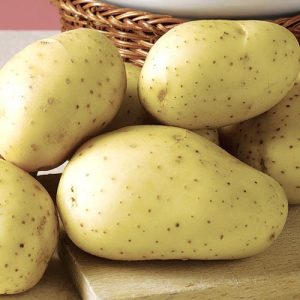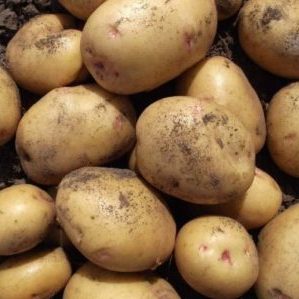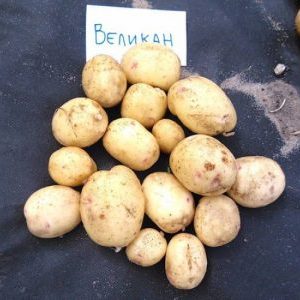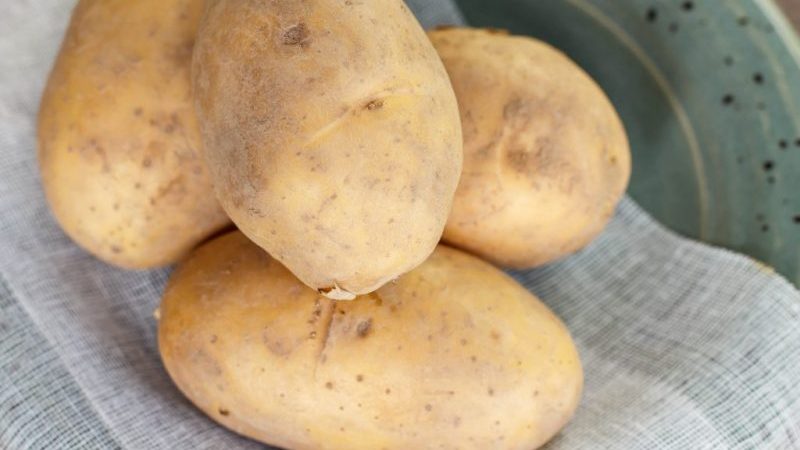High-yielding potato variety Giant with large tubers
Potatoes are an integral part of the diet of a modern person. First and second courses, pastries and even unusual desserts are prepared from it. Experienced housewives say that it is better to choose different varieties of potatoes for cooking, frying and mashed potatoes. However, there are also versatile options. They are the most popular among gardeners.
These varieties include the Giant potato. It is suitable for preparing any kind of food and has a rich taste. The variety is famous not only for this. It has other advantages that make it more and more popular - high yield, disease resistance, large fruit size and transportability.
The content of the article
General description of the variety
The giant is a product of domestic selection. Its resident is the A.G. Lorkh All-Russian Research Institute. The variety is relatively young.
Distinctive features of the Giant
Aligned large tubers are considered the main distinguishing feature of the Giant potato. In the harvest, they are the overwhelming majority - non-commercial trifles are extremely rare.
Important! The size of this potato variety depends on the composition of the soil. The more nutritious the soil, the larger the tubers will be.
The Giant contains an increased amount of starch. Thanks to this property, the variety acquires a golden crispy crust when fried and baked.
 Potatoes contain many useful substances. Among them:
Potatoes contain many useful substances. Among them:
- vitamins B, A, C, PP, K, E, betaine, beta-carotene, lutein;
- micro- and macroelements - potassium, calcium, zinc, selenium, manganese, phosphorus, sodium, magnesium, iron;
- fatty acids, including Omega-3 and Omega-6;
- nonessential and essential amino acids.
Main characteristics of the Giant potato
The Giant potato is a variety that will definitely not let you down. It gives a rich harvest even in dry summers and is unpretentious.
Characteristics of the Giant potato:
| Parameter | Index |
|---|---|
| Ground part of the plant | The bushes are tall, semi-erect. Medium spreading. Form a rich green mass. The leaves are large, with a wavy edge. The color is dark green, dull, matte. The veins are clearly defined. Inflorescences are compact, composed of small red-violet flowers. Few berries are formed. The plant fades quickly. The root system is powerful. 10-15 large tubers are formed under each bush. |
| Tubers | Large, aligned, oval-round. The mass of each tuber varies within 100-150 g. The skin is thin, but strong, glossy, smooth, light beige. The pulp is creamy, yellowish. Sweetish taste, rich aroma. It does not darken when cutting. During heat treatment, it becomes moderately crumbly, but not boiled down... There are many eyes, they are deepened but inside and pigmented with pink color. The starch concentration in tubers is high - 17-19%. |
| Ripening terms | Mid-season. From sowing tubers to harvesting, 70-90 days pass. |
| Yield | High. From 1 m² landings harvest up to 5 kg. One bush gives up to 15 tubers. They are all large. Marketability reaches 97%. |
| Transportability | High. The tubers are suitable for long distance transport. They are stored throughout the winter without changing the taste. |
| Disease immunity | Has a high immunity to potato crayfish, leaf rolling, striped and wrinkled mosaics, rhizoctonia, scab. Resistance to late blight and aureus nematode is low. |
| Growing features | Recommended for cultivation in the Central, Central Chernozem and Volgo-Vyatka regions. |
The main advantages and disadvantages of the variety
Advantages of the Giant:
- universality of application;
- excellent taste of tubers;
- drought tolerance;
- immunity to temperature extremes;
- immunity to most nightshade diseases;
- large-fruited;
- high transportability and keeping quality.
Disadvantages of the Giant:
- low resistance to late blight and golden nematode;
- exactingness to the composition of the soil.
Features of planting and growing
Potatoes are grown in a seedless way, by planting tubers directly into the ground. They do this when the soil at a depth of 15 cm warms up to a temperature of + 10 ° C. If you do this earlier, the tubers will rot.
In regions with a temperate climate, potatoes are planted in late April or early May, and in southern cities in early April. They begin to prepare for this no later than a month in advance.
Preparing for planting tubers
The planting material is sorted out. Large tubers without signs of disease and damage are suitable for growing.
To protect potato plantings from diseases and increase their resistance to negative environmental factors, it is important to properly prepare them:
- Treat with a light pink solution of potassium permanganate or copper sulfate (1 teaspoon per 3 liters of water). The tubers are immersed in this product for half an hour. Then they are completely dried.
- Next time, rinse the tubers with a solution prepared from 3 liters of water and 0.5 tsp. boric acid. The processed potatoes are allowed to dry completely.
- Stimulate germ formation. To do this, the potatoes are immersed in any growth stimulator ("Solution") prepared according to the instructions.
Processed potatoes are laid out on sawdust or newspaper in a bright place. Periodically, the tubers are sprayed with water at room temperature.
After 2-4 weeks, shoots appear on the planting material. When they become strong and long, the tubers are harvested in a room with a temperature of + 10 ... + 12 ° C for 48 hours.
Soil preparation and sowing of planting material
For the cultivation of the Velikan variety, the most illuminated place with deep groundwater is chosen.
Selected beds should not have nightshade crops growing for the past 2 years. The best precursors for potatoes are cabbage, onions, carrots, garlic, any spicy herbs and green manure plants.
They begin to prepare the beds in the fall. They are dug to a depth of 30 cm and all larvae are removed. Plants are examined: if there are no signs of diseases, then they are buried in the ground.
For every 1 m² in the fall, 5-6 kg of manure must be applied. Slightly acidic soils are suitable for potatoes. If the indicators are increased, they are corrected with dry lime or ash.
Advice! Instead of tops of plants in the fall, peelings of fruits and vegetables, stale bread and other food waste are buried in the ground.
In the spring, the beds are dug again to the depth of the shovel bayonet. Pest larvae are harvested again. To enrich the composition of the soil, 30 g of superphosphate and 15 g of urea are added for each 1 m². Some gardeners add an additional 4 kg of humus. Fertilizers are thoroughly mixed with soil.
Potato holes are placed in rows in a checkerboard pattern. A distance of 30 cm is maintained between the grooves, and 60-80 cm between the rows.The depth of the holes varies from 6 to 10 cm.
A handful of ash or granular long-acting fertilizers are thrown into each depression. Then place 1 potato each and cover them with soil, without compacting the soil. The beds are watered.
Basic rules of care
The Giant's harvest depends on caring for it. To get maximum performance, it is important to follow the basic rules:
- Tubers planted in the ground need good air exchange. Therefore, the soil is loosened until the first shoots appear at least 2 times.This is done with a rake, removing weeds.

- The beds are loosened after each watering and rainfall and are regularly cleared of weeds.
- In dry summers, potato beds are watered 3-4 times. The first watering is done before the first hilling. Then the soil is moistened 1 time before flowering, when the first inflorescence appears and after the bushes have faded. Use warm water for irrigation. The procedure is carried out after sunset or early in the morning. If the summer is rainy, it is not necessary to water the beds.
- Potatoes are spud at least 2 times. This allows you to significantly increase the yield of the Giant. The first time, the ground is raised with ridges 6 cm, when the plants reach a height of 15 cm. The second - after 2-3 weeks. Then hilling is carried out only if the ridges are washed out by precipitation. The soil for this is taken from the aisles.
The giant is picky about feeding. They allow you to get the maximum yield. For the entire season, fertilizer is applied to potato beds at least 4 times:
- After 2 weeks, after the shoots appear, the potatoes are fertilized for the first time. Most gardeners recommend using chicken manure or mullein diluted 1:10 with water. For each plant, 1 liter of the product is applied. Sometimes such a composition is replaced with a urea solution or silage.
- The second time the Giant is fed is when the first bud is formed. During this period, it is recommended to use any fertilizer containing potassium and phosphorus or ash diluted at the rate of 1 tbsp. for 1 bucket of water.
- The last time feeding is applied during the period of mass flowering. It is useful to use herbal infusion. For its preparation, a quarter of the bucket is filled with chopped herbs, 1 kg of chicken manure is added there. All are poured with ice water and left to infuse for several days.
- The last top dressing is foliar. 10 days before harvesting, the plants are sprayed with a superphosphate solution (25 g per 1 bucket of water).
The advice of an experienced summer resident
Weeding is the most frustrating part of growing potatoes. Therefore, farmers have found a way to do without this procedure, as well as loosening the soil. For this, the beds are covered with a layer of straw, renewing it after each watering.
Such a layer protects plants not only from weeds, but also from many pests.
Disease and pest control
Potato Giant has a low resistance to late blight. To avoid contamination of plants, they are sprayed with a solution of copper sulfate (1 tablespoon per bucket of water) during epidemics, after rains and during cold snaps. The affected plants are removed and discarded, after which the soil and healthy bushes are treated with fungicides.
The most dangerous pest that affects the Giant is the nematode. Sick plantings cannot be saved. To prevent the disease, nematicides are introduced into the beds a month before the tubers are laid.
Note! Nematicides have a phyto-suppressive effect. Therefore, after laying the tubers, they cannot be introduced.
To protect plants from the Colorado potato beetle, the bushes are treated with folk remedies (soapy water, ash, decoction of bitter herbs) or special preparations (Tabu, Barrier). Many gardeners do not treat the bushes for this pest, but collect it by hand.
The removal of their larvae when digging the beds will protect the plants from the bear and wireworm.
Harvesting and storage

The Giant's harvest is ready for harvest in early August. This is evidenced by the withered tops of plants. Summer residents recommend cutting the tops of potatoes in a week of harvest. Then the fruits will be the most delicious.
The potatoes are dug out with a pitchfork to minimize damage. Since the tubers are light, they are easy to spot in the ground.
Important! Potatoes are dug up only in dry weather. Otherwise, the tubers will be dirty.
After removing from the ground, the potatoes are allowed to dry and carefully cleaned of dirt with dry material. Then it is sorted out, removing all damaged and infected tubers.They are sorted by size, it is recommended to store small and large potatoes separately.
Immediately lay the tubers the size of a chicken egg on the seeds. They are kept separate from the rest of the crop.
Potatoes are packed in wooden boxes, plastic nets or dry clean bags and stored in a dry, dark place.
Giant - excellent quality potatoes, versatile in application... Suitable for boiling, frying, baking and mashing.
Farmers' reviews about the Giant
The Giant potato variety is distinguished by aligned tubers - exactly as in the photo and in the description from the originator. Reviews of summer residents about this culture are mostly laudatory.
Irina, Voronezh: «I tried many varieties of potatoes, among them there were even blue ones. Last year she planted a Giant. Really decent option. Not to say that it is a giant, but practically does not produce small tubers. And the taste is excellent. I grew it by the standard method, in holes, I made only three top dressing per season. The harvest was amazing. I like that potatoes are good when fried and do not fall apart during cooking. "
Alexander, Kursk: “I liked the giant. Large tasty potatoes. The pulp is yellow. The crust is smooth and creamy as shown in the photo. The only negative - last year I fell ill with late blight. Therefore, a lot of attention must be paid to processing. In the second half of summer, once a week I spray the bushes with copper sulfate. "
Read also:
Who grew the largest potato in the world and what does it look like.
Why is potato juice useful for hair and how to use it correctly.
What is the calorie content of potatoes and do they get fat from it?
Conclusion
The Giant is a high-yielding variety whose performance exceeds all standards. Moreover, almost all of its tubers are large and have the correct shape. If you are looking for a versatile option with a stable yield, you should take a closer look at this particular variety.
So that the Giant does not disappoint you, it is important to timely feed and follow the rules of disease prevention.